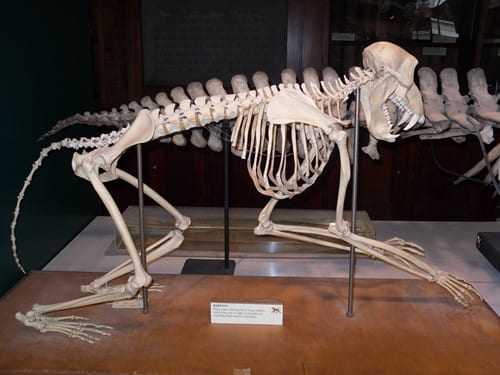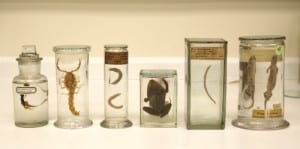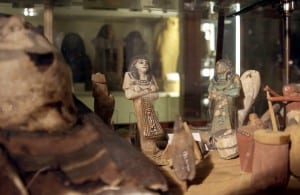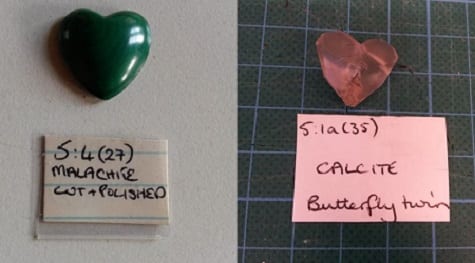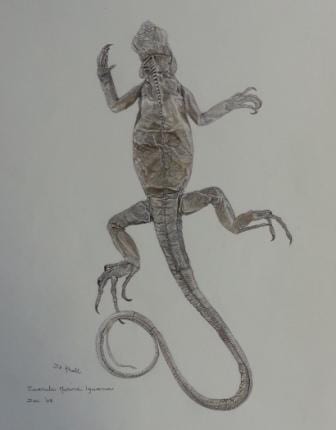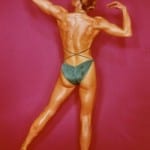Meet our Volunteers!
By Lisa Randisi, on 15 May 2020
In today’s blog, we’d like to introduce you to some people without whom a visit to our museums simply wouldn’t be the same: meet some of our wonderful team of Front of House volunteers! Here they tell all about their favourite artefacts, valuable life lessons, and what they’d do if they got to spend a night at the museum…
Please introduce yourself in a few words:
“I’m Chris, a Welsh Egypt fanatic who’s lived in France and East Africa and has dabbled in Innovation, linguistics, history and the Civil Service!”
“Hello, I’m Margaret and I did biology at UCL (which is how I start volunteering). I’m normally in the Grant as it’s my favourite of the museums and just a very cool space to be in. In my spare time, I’m normally playing the cello or reading – I love a good murder mystery! I’ve been volunteering for over three years now and each time I come in, I’ve always had a different experience.”
“Hello! J My name is Sian & hopefully you might have seen me around and about the Petrie Museum as I have been here for over 2 decades now. I’m the one who uses any opportunity to arrive in fancy dress! I’m a full-time self-employed Aromatherapist, Clinical and Holistic Massage Therapist.”
“Hi! My name is Tonia and I am a final year Undergraduate studying Archaeology and Anthropology here at UCL. I’ve been volunteering for just under two years.”
“Hello, I’m April – and before you ask, I was not born in April, it was actually October. I am also 31 and I live in Hertfordshire. I have loved Ancient Egypt since I was quite small: I remember my Granny showing me a travel book written by a painter called R. Talbot Kelly. Apparently he was also her great uncle! The book fascinated me and unfortunately for my parents, I wanted to learn more about the country he went to and painted and that’s where it all began. Since then I have accumulated quite the collection of books and other Egyptian stuff, I have also managed to get myself a degree in Egyptology with the future hope of maybe getting a Masters and PhD. I also have an obsession with dragons, books, video games and Heavy Metal music.”
Why did you decide to volunteer?
“I’ve always been fascinated by Egyptology and love museums. The Petrie has an amazing collection and I wanted to learn more about it. I also wanted to do something that involved working with the public (you never know who’s going to walk through the door next!)” – Chris
“I wanted to volunteer because of a class practical I had in the Grant during my first year. I realised it was such a great place with some very awesome specimens so I wanted an opportunity to come back and spend more time in here.” – Margaret
“My Degree was in Archaeology and History, and Masters degree was in Archaeological Research so when I was a working archaeologist after leaving University I decided to volunteer at the British Museum. About 6 months later I attended an Egyptian Mummy Study Day at the Bloomsbury Summer School (with Professor Joann Fletcher) & they suggested we visit the Petrie Museum in our lunch hour – just trying to find the Museum was an adventure. Back then you had to go through the Science Library and the back door was the front – it was like stepping into a hidden world…” – Sian
“Museums have been a source of fascination for me since I was a child and are what inspired me to study the degree I do. When I saw the opportunity to volunteer with UCL Culture I jumped at the chance! It also gives me a welcome break from university work as well…” – Tonia
Favourite object or specimen?
 “My favourite specimen is the humble yet mighty hedgehog! It looks very prickly but has such a soft belly which is something most people don’t think of when they look at it. So it’s nice to have been able to see and touch the secret underside of this adorable animal.” – Margaret
“My favourite specimen is the humble yet mighty hedgehog! It looks very prickly but has such a soft belly which is something most people don’t think of when they look at it. So it’s nice to have been able to see and touch the secret underside of this adorable animal.” – Margaret
“A steatite seal-amulet depicting the form of a cat carrying a kitten. Aesthetically, I love the detail on such a small object. On a more intellectual basis, the concept of magical or ritual protection against unseen forces has long been a source of interest – especially for the anthropologist in me.” – Tonia
“The board games in the Petrie. I love the way things brings out the “fun” side of day-to-day life in Ancient Egypt. They help bring a civilisation to life, to connect as human beings with people who lived back at that time and remember history isn’t all just about king-lists and dates.” – Chris
 “Anyone who has spoken to me knows – the Socks! 🙂 Again as an archaeologist I get way more excited about the preservation of materials that we don’t normally see far more than gold and treasure (which survive well). So first, I simply love that wool has survived. Secondly, I had absolutely no idea that Ancient Egyptians knitted or wore woollen socks; it was really surprising, although in retrospect desert temperatures do drop very low at night.” – Sian
“Anyone who has spoken to me knows – the Socks! 🙂 Again as an archaeologist I get way more excited about the preservation of materials that we don’t normally see far more than gold and treasure (which survive well). So first, I simply love that wool has survived. Secondly, I had absolutely no idea that Ancient Egyptians knitted or wore woollen socks; it was really surprising, although in retrospect desert temperatures do drop very low at night.” – Sian

“Say what, just one? Let me think. I really enjoy looking at the Hieroglyphs, the way they are carved or written so much better than my feeble attempts at drawing them. But I think my favourite object is the Will of Antef Meri, in the Main Gallery on the left of the big table. It is written in the dreaded Hieratic script but what I love about it is that it gives us a glimpse into someone’s life and what he was planning to do with his estate when he died. To actually have a nearly intact will, similar to one that would be drawn up today, is quite surprising. I wonder how many more there are out there.” – April
If you were locked inside the Petrie or Grant museum overnight, what would you do?
“Do my happy dance all around the Petrie museum and finally be able to look at and read every single thing! I have always dreamed of a sleepover to be honest, but I don’t think I’d sleep all night – it’s way too exciting!” – Sian
“I’d devise a new trail / treasure hunt through the collection to entertain myself and future visitors. I’d probably also play a lot of the board games in the Petrie!” – Chris
“If I were stuck in the Grant, I would explore the gallery upstairs first as there’s some very cool specimens up there that we don’t normally get to see. Secondly, I would also go around the museum sketching/photographing as many specimens as I could to compile into my very own personal museum catalogue. “ – Margaret
“I would study up on as many of the objects as possible – it would be nice to have the time to do so!” – Tonia
“Wait – do I get snacks? Because I might have to break out and buy snacks, I’m terrible for buying snacks. And don’t worry, I wouldn’t eat in the galleries! With my parents and I having to stay in all the time at the moment, the noise and constant talking can get a bit irritating, so having an overnight stay in the museum wold be wonderful. Have some snacks, a screen somewhere to watch some Ancient Egypt documentaries and slouch in a sleeping bag or blankets and pillows. It would be a wonderfully quiet night, nothing too exciting.” – April
What do you like most about volunteering in museums?
“The people! Such a variety of personalities with different interests come through museum doors that I genuinely learn something new every day.” – Tonia
“I love working with people, but as an ex-archaeologist I have to say it’s the privilege of working with all those artefacts and seeing behind-the-scenes. I’m as happy as a pig in muck just being in the Museum to be honest!” – Sian
“I think, strangely enough since I am not usually a people person, it is meeting all different kinds of people and having the chance to chat to them around a topic I know about. You get to meet people from all over the world and you get to see a small glimpse into their lives.” – April
“The best part is seeing how enthusiastic visitors are when they come in. In particular, the enthusiasm of some of our younger visitors is very contagious and such a joy to see.
It’s also really great to hear the feedback from people as they leave – they always leave full of awe and wonder which is fantastic to see.” – Margaret
What’s a valuable life lesson that museums have taught you?
“Learning isn’t just about locking yourself away in a study. It’s about getting out and interacting with people who share your sense of curiosity.” – Chris
“Not to assume anything and that people in ancient times usually have a lot more in common with us than we realise.” – Sian
“The museums have shown me that every single person has something they don’t know but can learn about. This shouldn’t be seen as a flaw necessarily but it makes all of us a little bit more human. It means that there’s always opportunities for us to be inquisitive about the world around us and improve our knowledge of it.” – Margaret
“No society or individual has any more or less value than another.” – Tonia
Bonus question: What are you going to spend time doing while on lockdown?
“I’m spending a lot of time reading about Ancient Egypt and about Twin Peaks (I’m afraid I also love that classic early 90s David Lynch melodrama and would recommend as escapism to anyone to help get through this crisis!). I’m also using the opportunity to get back into learning Chinese (along with hieroglyphics I always seem to pick the “easiest” languages!) and into international cuisine (with varying degrees of success).” – Chris
“I am currently unable to work as all my work is people-facing and hands-on. Also most of my clients are in the vulnerable category. I am currently doing what I usually do but for longer – so 3 hours meditation, practise and study instead of 1.5 hours; Tibetan energy healing practice and study; walking 2-6 miles a day; PE with Joe Wicks; gardening; blogging for my business website; advising and providing support for my clients; cooking and reading.” – Sian
“I’m lucky I’m a bit of a homebody anyway, although I am missing my friends and volunteering at the Petrie. Mostly I will be reading my many, many, many books; I’m so behind it’s hilarious. I also plan on continuing with my revision of Ancient Egyptian hieroglyphs. I learned tham at university and it has been a while since I’ve translated anything, so I’m re-reading J.P. Allen’s book. I’m also keeping alive my newly sprouted bonsai tree – and coming from a person who killed off a cactus, that is quite an achievement so far.” – April
“I have a mountain of books I have never read and a slightly smaller one of films I have never seen, hopefully I can start to make a dent 😉” – Tonia
“I have two very difficult jigsaws that I want to attempt. I’m currently still at the beginning of the first one so I think the two of them will keep me quite busy for the next month or so. I’m also thinking of tidying up the garden a bit but that might be just some wishful thinking on my part…” – Margaret
 Close
Close



